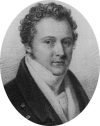JOHN MARTIN K.L.
(1789-1854)
 became the most popular British artist of his age gaining acclaim from the public throughout Europe though rarely from the contemporary English art establishment and critics.
became the most popular British artist of his age gaining acclaim from the public throughout Europe though rarely from the contemporary English art establishment and critics.
Martin's works reflected and capitalised on the 19th century preoccupation with grandiose biblical and romantically heroic subjects from literature.
His early life in Northumberland was spent in an area of wild rural topography with weather conditions to match. This was contrasted against the expanding local industrial and mining scene. Together with his family's staunchly religious Old Testament and forthright ways, these topics provided young John's artistic influences.
His bold concepts featured melodramatic and apocalyptic scenes of great destruction displaying neo-classic gothic horror but without the mangled corpses, morbid and erotic dreams and snakes of his predecessors. The genre was termed "the sublime" reflecting atmosphere, vastness, tragedy and death.
Johnstone, C in his book 'John Martin' 1974 proposes that his career was that of a Renaissance humanist. His aim as an artist is probably best summed up in Martin's own words, taken from the prospectus for 'The Illustrations of the Bible' (1835): it was to avail himself 'of all objects afforded by inanimate nature, as well as by the passions and ingenuity of man, by bringing before the eye the vast and magnificent edifices of the ancient world, its forests, wilds, interminable plains, its caverns and rocks and mountains, by freely employing the aid of its powerful and primitive elements of fire and water,which, when agitated by their Almighty Disposer (using the language of the poet) "between the green sea and the azure vault sets roaring war." '
The large canvases remain stunningly effective.
However, the visions extended beyond mere painting. His interests progressed to:-
- Lithography and Printing
- Architecture
- Town Planning
- Water Supply Engineering
- Mine Safety and Ventilation
- Sea and Inland Waterway Navigation and Safety
- Marine Engineering with an 'Elastic Iron Ship'
- Cabinet Making
- Palæontology and Darwinism
- Environmental Management Through Clean Air and Sewage Schemes
- Fertiliser Production from Waste Effluent
- Healthy Living and Exercise for the Public to Combat Drunkenness
- Chess Master
- Hosting weekly parties where the great artists and authors could network with the leading academics, scientists and entrepreneurs of the day
Some of these 'Plans' nearly brought about his financial ruin.